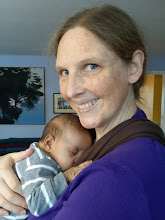Yes, that’s right. Panama. I was there, though I have nothing to show for it—not even a stamp in my passport—except some blurry seascape photos from the balcony of a 5-star hotel.
Tuesday night, as the plane descended toward San José, I was musing on what an easy trip it had been. Everything had run on time; I’d had plenty of time to get to the international terminal in Atlanta. They didn’t even make me pay overweight charges on my giant duffle, though I’m pretty sure it was a few pounds heavier than it should have been. I wondered, as I stared idly out the window at the city lights and a distant thunderstorm, what could go wrong this trip. I was kind of half-hoping the airline would lose my luggage, so I wouldn’t have to worry about negotiating the Caribeños bus terminal with it in the morning. I think that all the time I’ve spent in Latin America has been good for my blood pressure: the expectation here is that nothing will run smoothly, and when things do it’s a pleasant surprise.
As the plane sank lower, the clouds closed in. The fog was so thick I could hardly see the wingtip light. The engines droned; I felt the thump of the landing gear coming out. Then suddenly the plane lurched upward and climbed again with stomach-wrenching speed. The captain came on the intercom a few moments later, sounding more shaken than I’d ever heard a captain sound. “Uh, folks, we had a little visibility issue here with ground fog around the airport. We got down to about 300 feet and we still couldn’t see a thing. We don’t have the capability to land on instruments here, so we’re just going to, uh, go into a holding pattern for a bit and see what happens.” Airline captains are generally such stalwart examples of Midwestern bland good cheer. It was rather nerve-wracking to hear his composure slip.
A few minutes later: “Folks, this is your captain again. We have just received word from the tower that the airport is closed. Nobody’s getting in or out right now, and we don’t know how long that’s going to last. We are headed down to Panama City and hoping we can land there.” And so we did, getting into the airport a little after midnight. With nothing but carry-on luggage, the motley herd of passengers—including two high school groups, who seemed to enjoy the proceedings greatly—was waved through customs and immigration with only a cursory glance at our passports. We loaded into buses at the curb, the night air still hot and steamy, redolent of wilting flowers and diesel exhaust. The first class passengers were deposited at a hotel half an hour from the airport, and the rest of us headed out into the countryside. It was a long, long road with absolutely no lights on either side. I speculated with my seatmate, a fashionable young tica, about whether we’d end up in army cots in the middle of the jungle somewhere.
Eventually—well past one—the bus reached our destination, the Hotel Intercontinental Playa Bonita. The place was quite grand, with live orchids all over the lobby, a private beach, and two giant swimming pools. Unfortunately we had all of six hours in which to enjoy it, and I spent most of that time sleeping.
In the morning I did get to play a halfway decent piano in the lobby, so the little detour was worthwhile. I also got free lodging for the night, coffee and a stale roll for breakfast (apparently marooned air travelers don’t merit the full five-star treatment), and a view of the Panama Canal from the bus. All in all, a nice—if quick—vacation to Panama. I must say, though, that I’m very glad to be in Costa Rica.














